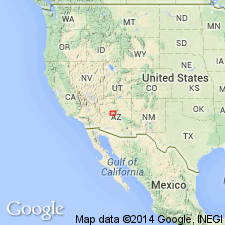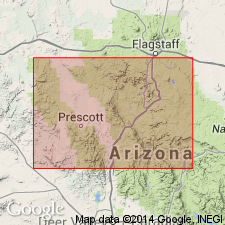
- Usage in publication:
-
- Chino Valley Formation
- Modifications:
-
- Named
- Dominant lithology:
-
- Sandstone
- Conglomerate
- Dolomite
- AAPG geologic province:
-
- Basin-and-Range province
Summary:
Named [probably] for Chino Valley which lies along Colorado Plateau border south of Grand Canyon and northwest of Jerome, Yavapai Co, AZ, Basin-and-Range province. Type section designated in abandoned quarry 2 km northwest of Jerome, NE1/4 NW1/4 sec 21, T16N, R2E. Formerly included in Tapeats Sandstone as its upper unit. Includes strata between Tapeats (lower unit of Tapeats of earlier reports), and Martin Formation. In same stratigraphic position as Bright Angel Shale which pinches out at South Butte. Both contacts vary from sharp to gradational. Extends for 75 km from Partridge Creek to Jerome; may extend another 60 km southeast. Maximum thickness 13 km. Laterally equivalent, mutually exclusive, east to west facies: 1) lithic sandstone with granules and pebbles dominantly of dolomite, some siltstone and sandstone clasts, and sparse authigenic glauconite derived from Cambrian sedimentary terrain; 2) conglomerate of subround to round quartzite pebbles in dolomitic matrix interbedded with dolomite granule conglomerate, coarse dolomitic sandstone, coarse sandstone, and coarse crystalline quartzose dolomite deposited in a fluviatile shallow nearshore area; and 3) gray-red to gray-yellow, green, slightly quartzose and micaceous dolomite (facies at type) deposited in a mudflat. Location of 7 sections given for each facies. Cambrian? age. Younger than middle Middle Cambrian; older than Devonian. Stratigraphic diagrams.
Source: GNU records (USGS DDS-6; Denver GNULEX).

- Usage in publication:
-
- Chino Valley Formation*
- Modifications:
-
- Age modified
- AAPG geologic province:
-
- Basin-and-Range province
Summary:
Age changed from Cambrian? to Devonian on basis of recognition of a major erosional break between Chino Valley and underlying Upper Cambrian Tapeats Sandstone. Unconformity marked by surface with 1 to 6 m relief. Tapeats was extensively reworked and incorporated into Chino Valley sediments. Is probably equivalent to Beckers Butte Member, basal member of Devonian Martin Formation. Report area lies in Chino and Verde Valley areas, central AZ, Yavapai Co, Basin-and-Range province.
Source: GNU records (USGS DDS-6; Denver GNULEX).
For more information, please contact Nancy Stamm, Geologic Names Committee Secretary.
Asterisk (*) indicates published by U.S. Geological Survey authors.
"No current usage" (†) implies that a name has been abandoned or has fallen into disuse. Former usage and, if known, replacement name given in parentheses ( ).
Slash (/) indicates name conflicts with nomenclatural guidelines (CSN, 1933; ACSN, 1961, 1970; NACSN, 1983, 2005, 2021). May be explained within brackets ([ ]).

